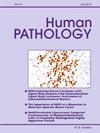Leukemic phase of MYC/BCL2 double-hit high-grade B-cell lymphoma: A report of 35 cases
IF 2.6
2区 医学
Q2 PATHOLOGY
引用次数: 0
Abstract
We report 35 patients who had a leukemic phase of diffuse large B-cell lymphoma/high-grade B-cell lymphoma with MYC and BCL2 rearrangements, also known as double-hit lymphoma (DHL). There were 23 men and 12 women with a median age of 57 years (range, 29–82). Eight patients had an established DHL diagnosis and subsequently developed a leukemic phase of disease and 27 presented with DHL and a leukemic phase of disease at initial diagnosis. Thirty patients had not received any therapy specific for DHL at time of diagnosis. For these 30 patients, the median leukocyte count was 16.6 × 109/L (range, 1.6–191.3) and the median percentage of lymphoma cells in the blood was 39 % (range, 10–97). Many patients presented with a clinical picture mimicking acute leukemia. Laboratory studies revealed elevated serum lactate dehydrogenase levels in all patients assessed, with a median level of 7507 U/L (range, 377–39,022). All patients had bone marrow involvement, with a median of 82% lymphoma cells in aspirate smears and approximately 80% replacement in biopsy specimens. Twenty-nine of 31 (94%) patients with complete information had extramedullary disease, most commonly lymph nodes. Immunophenotypic analysis showed a CD10-positive, germinal center B-cell immunophenotype in 34 cases. Conventional cytogenetic analysis was successful in 27 cases, all showing a complex karyotype. MYC partners were known in 22 cases, with immunoglobulin (IG) gene partners in 19 and non-IG partners in 3 cases. Despite treatment with chemotherapy regimens, overall survival was poor with a median of 7 months from onset of leukemic phase of disease. In summary, a small subset of patients with DHL can present with or develop a leukemic phase of disease which is a harbinger of very poor prognosis.
MYC/BCL2双击高级别b细胞淋巴瘤白血病期35例报告
我们报告了35例弥漫性大b细胞淋巴瘤/高级别b细胞淋巴瘤伴MYC和BCL2重排的白血病期患者,也称为双重击中淋巴瘤(DHL)。男性23例,女性12例,中位年龄57岁(29-82岁)。8名患者有明确的DHL诊断,后来发展为白血病期,27名患者在最初诊断时出现DHL和白血病期。30例患者在诊断为DHL时未接受任何治疗。这30例患者白细胞计数中位数为16.6 × 109/L(范围1.6 ~ 191.3),血液中淋巴瘤细胞百分比中位数为39%(范围10 ~ 97%)。许多患者表现出类似急性白血病的临床症状。实验室研究显示,所有患者血清乳酸脱氢酶(LDH)水平均升高,中位水平为7507 U/L(范围377- 39022)。所有患者均有骨髓受累,抽吸涂片中有82%的淋巴瘤细胞,活检标本中约有80%的淋巴瘤细胞。31例信息完整的患者中有29例(94%)患有髓外疾病,最常见的是淋巴结。免疫表型分析显示cd10阳性,生发中心b细胞免疫表型34例。常规细胞遗传学分析27例成功,均显示复杂核型。MYC伴伴22例,免疫球蛋白(Ig)基因伴伴19例(86%),非Ig伴伴3例。尽管接受了化疗方案的治疗,但总体生存期较差,从白血病期开始的中位生存期为7个月。总之,一小部分患有DHL的患者可以出现或发展为疾病的白血病期,这是预后非常差的预兆。
本文章由计算机程序翻译,如有差异,请以英文原文为准。
求助全文
约1分钟内获得全文
求助全文
来源期刊

Human pathology
医学-病理学
CiteScore
5.30
自引率
6.10%
发文量
206
审稿时长
21 days
期刊介绍:
Human Pathology is designed to bring information of clinicopathologic significance to human disease to the laboratory and clinical physician. It presents information drawn from morphologic and clinical laboratory studies with direct relevance to the understanding of human diseases. Papers published concern morphologic and clinicopathologic observations, reviews of diseases, analyses of problems in pathology, significant collections of case material and advances in concepts or techniques of value in the analysis and diagnosis of disease. Theoretical and experimental pathology and molecular biology pertinent to human disease are included. This critical journal is well illustrated with exceptional reproductions of photomicrographs and microscopic anatomy.
 求助内容:
求助内容: 应助结果提醒方式:
应助结果提醒方式:


